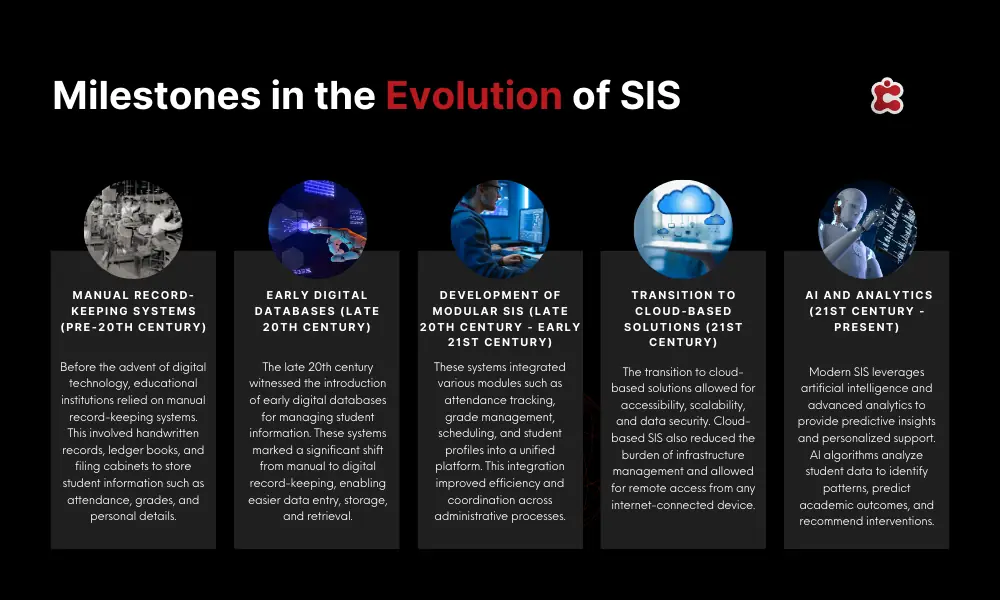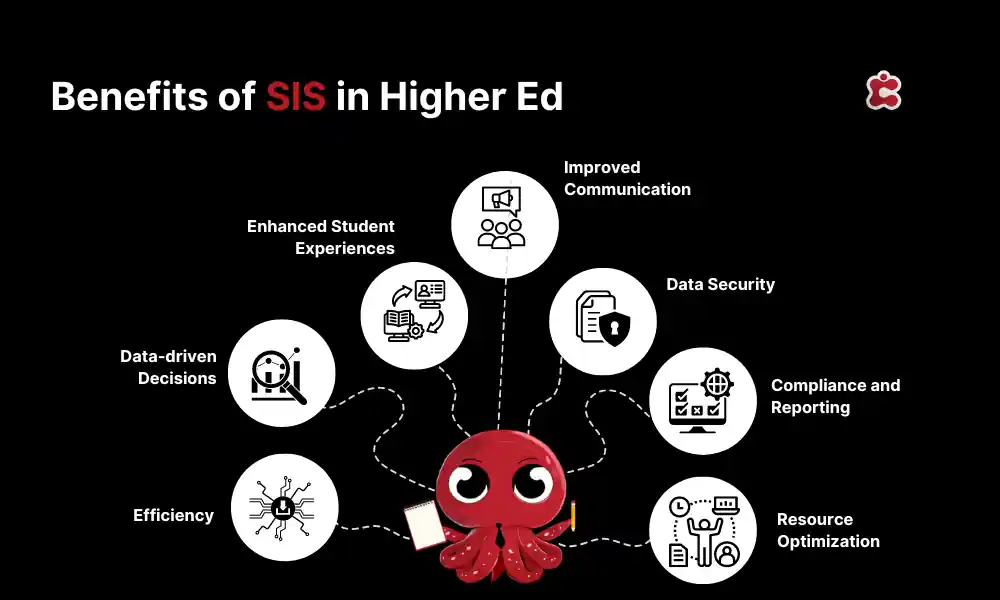Having the right tools and systems in place is priceless for any organization. And higher education is no exception. With the complexities and vast number of products, systems, and software in the market, making the right choice is daunting. Yet, for college deans tasked with the responsibility of steering their institutions toward success, it’s not just about choosing any tool—it’s about selecting the right ones that can truly make a difference.
Student Information Systems (SIS) have been making waves in the educational space. These sophisticated platforms have emerged as indispensable assets in higher education administration. Initially, SIS began as rudimentary databases designed to manage basic student information such as enrollment, grades, and attendance. However, as technology advanced and the demand for more comprehensive solutions grew, SIS underwent a remarkable transformation.
So, how did these systems come about? How have they evolved into what we see today? How do they work? And most importantly, how do they benefit colleges, universities, and institutions?

Evolution of Student Information Systems
Let’s begin by explaining how and why these systems came about and how they have evolved over time, shaping the landscape of higher education management as we know it today.
Manual Record Keeping (Pre-Computer Era):
Prior to the advent of computers, student information was managed manually using paper-based records. Colleges relied on handwritten documents and filing systems to track enrollment, grades, and other administrative data. This method was labor-intensive and prone to errors, making maintaining accurate and up-to-date records challenging.
Emergence of Early Computer Systems (1960s-1970s):
The 1960s and 1970s saw the emergence of early computer systems in higher education. Universities began experimenting with mainframe computers to automate basic administrative tasks, laying the groundwork for the development of Student Information Systems. These early systems were rudimentary and often limited to simple data storage and retrieval functions.
Advancements in Integrated Systems (1980s-1990s):
Throughout the 1980s and 1990s, Student Information Systems evolved into more integrated platforms capable of managing various administrative functions. Institutions started adopting comprehensive systems to handle admissions, registration, financial aid, and other student-related processes within a unified framework.
Transition to Web-Based Systems (2000s):
With the rise of the internet in the early 2000s, Student Information Systems underwent a significant transformation. Colleges and universities transitioned from legacy, on-premises systems to web-based platforms, allowing for greater accessibility and collaboration. Online portals and self-service functionalities became standard features, empowering students to manage their academic journey more independently.
Advent of Cloud-Based Solutions (the 2010s):
In the 2010s, cloud computing revolutionized how Student Information Systems were deployed and accessed. Cloud-based solutions offered scalability, flexibility, and cost-effectiveness, allowing institutions to offload infrastructure management and focus on core activities. Moreover, cloud-based SIS facilitated seamless integration with other educational technologies, enabling interoperability and data exchange across disparate systems.
Impact of SIS on Higher Education Management
In examining the Impact of SIS on Higher Education Management, it’s evident that these systems have become indispensable tools for college deans seeking to navigate the complexities of modern academia.
Firstly, SIS has revolutionized efficiency within higher education institutions. By automating administrative tasks such as registration, grading, and course scheduling, SIS significantly reduces paperwork and streamlines processes. This saves valuable time and allows administrative staff to focus on more strategic initiatives.
Moreover, SIS empowers college deans to make data-driven decisions. By harnessing analytics for enrollment management, resource allocation, and academic planning, deans can gain valuable insights into student trends, preferences, and performance metrics. This enables them to optimize course offerings, allocate resources more effectively, and identify areas for improvement in academic programs.
Regarding student experiences, SIS is pivotal in enhancing communication and accessibility to academic information. Students can easily access their grades, course schedules, and academic resources through online portals and mobile applications. This creates a more seamless and personalized learning experience. Additionally, SIS enables institutions to provide proactive support and interventions tailored to individual student needs. Thus ultimately leading to higher levels of student satisfaction and success.
Lastly, SIS streamlines compliance and reporting processes, ensuring that institutions meet regulatory requirements and accreditation standards more effectively. By centralizing data and automating reporting workflows, SIS enables colleges and universities to maintain compliance while minimizing the administrative burden on staff.
Implementing SIS
Properly implementing your Student Information System (SIS) is crucial for maximizing its potential to streamline administrative tasks, enable data-driven decisions, and enhance the overall student experience. Here are some tips for ensuring a successful implementation:
1. Define clear goals and objectives for implementing the SIS, such as improving operational efficiency, enhancing student services, or optimizing data management processes. Having a clear vision will guide the implementation strategy and help prioritize tasks.
2. Involve key stakeholders throughout the implementation process, including faculty, staff, IT professionals, and student representatives. Solicit their input, address concerns, and ensure buy-in from all parties involved to foster a collaborative and inclusive approach.
3. Adequately allocate resources, including budget, time, and personnel, for the implementation project. Invest in training sessions, workshops, and support services to ensure that users are proficient in using the SIS effectively.
4. Customize the SIS to align with the unique needs and workflows of your institution. Work closely with the SIS vendor to configure the system to meet specific requirements, integrate with existing systems, and accommodate institutional policies and procedures.
5. Develop a comprehensive plan for migrating data from legacy systems to the new SIS. Ensure data integrity, accuracy, and security throughout the migration process, and conduct thorough testing to identify and address any issues or discrepancies.

Classter’s SIS for Higher Education
When it comes to managing student information effectively in higher education, Classter’s Student Information System stands out as the top choice for college deans. With a comprehensive suite of features designed to streamline administrative tasks and facilitate data-driven decisions, Classter offers a robust and intuitive platform that empowers institutions to excel.
Here are some key features that make Classter the best choice:
Comprehensive Student Profiles: Classter provides detailed student profiles, allowing educators to tailor learning experiences uniquely. With features like personalized learning journeys, academic progress tracking, and attendance monitoring, Classter ensures that every student’s needs are met.
- Efficient Enrollment Process: Classter streamlines the enrollment process, making it easier for institutions to welcome new students. From document management to course selection, Classter ensures a smooth transition for students and administrators alike. It sets the stage for a successful educational journey.
- Integrated Academic Scheduling: Classter’s advanced scheduling features ensure optimal class timings, teacher assignments, and room allocations. Thus maximizing efficiency while accommodating the diverse needs of students and faculty.
- Real-Time Grade and Attendance Tracking: Classter enables real-time monitoring and management of grades and attendance. This provides instant insights for informed decisions and timely interventions to support student success.
- Secure Data Management: Classter prioritizes the protection of student information with robust security measures. Now you can rest assured that sensitive data is safely stored and accessed in compliance with privacy laws and regulations.
With Classter’s SIS, college deans can simplify operations, focus on education, and make data-driven decisions that improve academic outcomes and enhance student experiences.
Book a demo with Classter today and discover how our comprehensive Student Information System can streamline administrative tasks, enhance student experiences, and drive academic success. Don’t miss out on the opportunity to transform your institution.
Student Information Systems have evolved from manual record-keeping methods to sophisticated, web-based platforms with features like real-time data tracking, personalized learning journeys, and secure data management.
When choosing a Student Information System, educational institutions should consider factors such as ease of use, customization options, integration capabilities, data security measures, and vendor support.
Yes, Classter’s SIS can be customized to align with educational institutions’ unique needs and workflows. Our team works closely with clients to tailor the system to meet specific requirements and integrate with existing systems.

